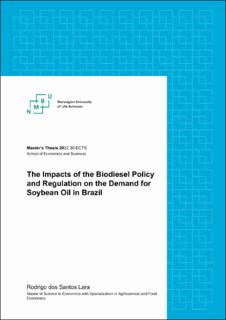| dc.description.abstract | Brazil started producing ethanol in 1975 as a response to the oil shocks from the 1970s. The Brazilian Ethanol program implemented the production and use of the new fuel by offering tax breaks and low-interest loans to sugarcane producers and to the automobile industry to produce cars that ran on ethanol. The ethanol program used regulation establishing a minimum amount of ethanol to be blended with gasoline. The program successfully implemented and encouraged the use of ethanol, reduced the use of gasoline, and boosted the sugarcane sector in Brazil.
Following suit, the National Program for the Production and Use of Biodiesel was launched in 2004. The biodiesel program’s main objectives were to create a domestic market for soybeans, to reduce diesel imports, and to have a green fuel as a substitute to diesel. The program also made use of regulation starting at 2 per cent of biodiesel to be blended with diesel which would, according to the plan, reach 15 per cent in 2023. In September 2021, the biodiesel content in diesel was reduced from 13 to 10 per cent to avoid an increase in diesel prices due to high soybean oil prices. Soybean oil is the main raw material for biodiesel in Brazil accounting for almost 70 per cent of the total. In 2020, due to the increase in the domestic demand, Brazil imported its second highest volume of soybean oil since 1961. This study aims at investigating whether the governmental decision to reduce in three per cent the biodiesel content in diesel makes sense considering the impact of the biodiesel policy and regulation on the demand for soybean oil. To do so, monthly data between January 2008 and December 2021 are used to analyze demand using Ordinary Least Squares (OLS) regression. First, we estimate the impact of the biodiesel production volumes on the demand for soybean oil – representing the impact of the biodiesel policy. Then, we estimate how much the impact of the biodiesel policy changes when the content of biodiesel in diesel is higher than 10% – representing the impact of the biodiesel regulation. The results show that the biodiesel policy has a positive impact on the demand for soybean oil which increases by 0.23% given a 1% increase in the production of biodiesel. When the regulation is in place, the impact of the biodiesel policy goes from 0.23 to 0.49%. The governmental decision from September 2021 to reduce the biodiesel content in diesel in three per cent makes sense considering the impact of the biodiesel policy and regulation on the demand for soybean oil. The regulation has a clear impact on the dynamics of the market. Reducing the content of biodiesel in diesel comes to soften the pressure on the domestic supply of soybean oil and to avoid an increase in the prices of diesel driven by high soybean oil prices. | en_US |

